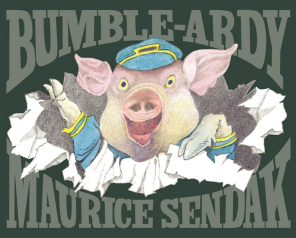By Dessa Bayrock (Contributor) – Email
Date Posted: October 19, 2011
Print Edition: October 12, 2011
 One of my favourite books as a kid was Maurice Sendak’s Where The Wild Things Are, and I’m sure I’m not the only one who demanded it read to me over and over. The idea of running away to be king of the monsters appeals to any kid, and the idea that kids will always want to come home again appeals to any parent. I still have it on my shelf, and I gave a copy to my four-year-old niece when she started reading. It’s getting close to 40-years-old, but some books just nail it and then keep it there. I am sorry to report that Sendak’s new children’s book, which was his first in thirty years and released last week, doesn’t even begin to measure up.
One of my favourite books as a kid was Maurice Sendak’s Where The Wild Things Are, and I’m sure I’m not the only one who demanded it read to me over and over. The idea of running away to be king of the monsters appeals to any kid, and the idea that kids will always want to come home again appeals to any parent. I still have it on my shelf, and I gave a copy to my four-year-old niece when she started reading. It’s getting close to 40-years-old, but some books just nail it and then keep it there. I am sorry to report that Sendak’s new children’s book, which was his first in thirty years and released last week, doesn’t even begin to measure up.
Bumble-Ardy is the somewhat confusing tale of a pig who turns nine and incurs the wrath of his guardian aunt by inviting circus performers to his first ever birthday party. Never mind that, in pig years, nine is well past maturity, and that the character’s name appears to have been chosen simply so the author has something to rhyme with the word party. The story itself simply doesn’t make much sense. Sendak is minimalistic at the best of times, but there’s a difference between sparse and lacking – the reader is never quite sure what is going on. Take, for instance, Bumble-Ardy’s sudden change from living with his parents (who have never thrown him a birthday party) to living with his aunt (who seems like a better choice, but apparently leaves the house for twelve hours at a time, allowing her nephew to party with creepy strangers for three spreads without dialogue).
From what I can tell, the message it tries to convey is supposed to be similar to that of Where The Wild Things Are: kids and parents don’t always get along but will always still love each other. However, Where The Wild Things Are is an obviously fantastical tale where the kid escapes into a magical but imaginary land, whereas the kid in Bumble-Ardy throws a large and out-of-control party. To be honest, it’s nice to be told that our parents will always love and forgive us, but I’m not sure we should be telling kids that they will be easily forgiven even if they throw crazy parties and invite complete strangers.
The one saving grace of the book is Sendak’s sense of rhythm, which never trips or falters. Although the rhymes are sometimes far from perfect (for instance, the Ardy/party conundrum), they are close enough to be excused; there are never any awkward or misplaced syllables. This might seem like it should be a given, but after the stacks of picture books I’ve gone through with my four-year-old niece, you’d be surprised how many authors and editors are incapable of spotting uncomfortable phrasing.
My love for Maurice Sendak is never-ending. He’s 83-years-old and an absolute hoot; I don’t think I’ve ever read more entertaining interviews with any author in my life, and I encourage you to look them up. Unfortunately, I’m incapable of extending this same appreciation to Bumble-Ardy. If you’re feeling nostalgic, and want to briefly return to the simpler time of picture books, go straight for the good stuff and reread Where The Wild Things Are. Bumble-Ardy is not worth your time.


